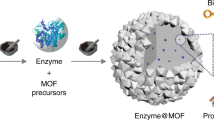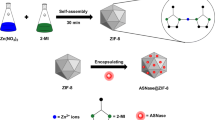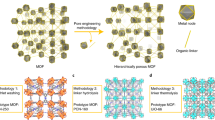Abstract
Expanding pore size range of metal—organic frameworks (MOFs) promotes their versatility and feasibility for various biomedical applications. However, natural pore size greatly restricts large guest molecule accommodation. Customizing and tailoring pore apertures ranging from micropores to mesopores controllably is desired but still critically challenging. Herein, we developed a facile method with super mildness based on pH-sensitive zeolitic imidazolate framework (ZIF)-8 to increase porosity, providing pore size with maximum 20 nm, which is 8 times larger than average. Glucose oxidase (GOx) was introduced in ZIF-8 for bioetching, benefitted from the resultant acidic microe-nvironment during biocatalytic process. Different synthesis methods were assessed for obtaining different morphologies and size distributions. Reaction time, GOx encapsulation efficiency, and Zn2+ concentration was optimized to precisely control the mesopore size distribution of MOFs. It was found that bio-etching strategy was capable of producing stable mesopores which were large enough for loading lactase with good enzymatic activity retained, verified both in vitro and in vivo. This strategy breaks natural pore size limitation of MOFs and thereby facilitates biomolecule delivery, catalysis, and other biomedical applications with enhanced stability and performance.

Similar content being viewed by others
References
Xue, D. X.; Wang, Q.; Bai, J. F. Amide-functionalized metal—organic frameworks: Syntheses, structures and improved gas storage and separation properties. Coord. Chem. Rev. 2019, 378, 2–16.
Wang, T. S.; Gao, L. J.; Hou, J. W.; Herou, S. J. A.; Griffiths, J. T.; Li, W. W.; Dong, J. H.; Gao, S.; Titirici, M. M.; Kumar, R. V. et al. Rational approach to guest confinement inside MOF cavities for low-temperature catalysis. Nat. Commun. 2019, 10, 1340.
Zhang, Y.; Ma, S. Q. Controllable immobilization of enzymes in metal—organic frameworks for biocatalysis. Chem Catal. 2021, 1, 20–22.
Tchalala, M. R.; Bhatt, P. M.; Chappanda, K. N.; Tavares, S. R.; Adil, K.; Belmabkhout, Y.; Shkurenko, A.; Cadiau, A.; Heymans, N.; De Weireld, G. et al. Fluorinated MOF platform for selective removal and sensing of SO2 from flue gas and air. Nat. Commun. 2019, 10, 1328.
Yao, M. S.; Xiu, J. W.; Huang, Q. Q.; Li, W. H.; Wu, W. W.; Wu, A. Q.; Cao, L. A.; Deng, W. H.; Wang, G. E.; Xu, G. Van der Waals heterostructured MOF-on-MOF thin films: Cascading functionality to realize advanced chemiresistive sensing. Angew. Chem. 2019, 131, 15057–15061.
Gao, X. C.; Cui, R. X.; Song, L. J.; Liu, Z. L. Hollow structural metal—organic frameworks exhibit high drug loading capacity, targeted delivery and magnetic resonance/optical multimodal imaging. Dalton Trans. 2019, 48, 17291–17297.
Zhang, X.; Chen, A.; Zhong, M.; Zhang, Z. H.; Zhang, X.; Zhou, Z.; Bu, X. H. Metal-organic frameworks (MOFs) and MOF-derived materials for energy storage and conversion. Electrochem. Energy Rev. 2019, 2, 29–104.
Yang, M. J.; Hu, X. H.; Fang, Z. S.; Sun, L.; Yuan, Z. K.; Wang, S. Y.; Hong, W.; Chen, X. D.; Yu, D. S. Bifunctional MOF-derived carbon photonic crystal architectures for advanced Zn-air and Li−S batteries: Highly exposed graphitic nitrogen matters. Adv. Funct. Mater. 2017, 27, 1701971.
Qi, X. Y.; Chang, Z. Y.; Zhang, D.; Binder, K. J.; Shen, S. S.; Huang, Y. Y. S.; Bai, Y.; Wheatley, A. E. H.; Liu, H. W. Harnessing surface-functionalized metal—organic frameworks for selective tumor cell capture. Chem. Mater. 2017, 29, 8052–8056.
Qi, X. Y.; Chang, Z. Y.; Fu, G. Q.; Chen, T. F. Modification of metal—organic framework composites as trackable carriers with fluorescent and magnetic properties. Nanotechnology 2021, 32, 105101.
Qi, X. Y.; Li, X. J.; Bai, Y.; Liu, H. W. Synthesis and applications of chiral metal—organic framework in the selective separation of enantiomers. Chin. J. Chromatogr. 2016, 34, 10–15.
Alsaiari, S. K.; Patil, S.; Alyami, M.; Alamoudi, K. O.; Aleisa, F. A.; Merzaban, J. S.; Li, M.; Khashab, N. M. Endosomal escape and delivery of CRISPR/Cas9 genome editing machinery enabled by nanoscale zeolitic imidazolate framework. J. Am. Chem. Soc. 2018, 140, 143–146.
Chang, Z. Y.; Li, F. X.; Qi, X. Y.; Jiang, B.; Kou, J.; Sun, C. B. Selective and efficient adsorption of Au (III) in aqueous solution by Zr-based metal—organic frameworks (MOFs): An unconventional way for gold recycling. J. Hazard. Mater. 2020, 391, 122175.
Chang, Z. Y.; Zeng, L.; Sun, C. B.; Zhao, P.; Wang, J. Y.; Zhang, L. N.; Zhu, Y. G.; Qi, X. Y. Adsorptive recovery of precious metals from aqueous solution using nanomaterials-A critical review. Coord. Chem. Rev. 2021, 445, 214072.
Wu, M. X.; Yang, Y. W. Metal-organic framework (MOF)-based drug/cargo delivery and cancer therapy. Adv. Mater. 2017, 29, 1606134.
Yuan, S.; Zou, L. F.; Qin, J. S.; Li, J. L.; Huang, L.; Feng, L.; Wang, X.; Bosch, M.; Alsalme, A.; Cagin, T. et al. Construction of hierarchically porous metal—organic frameworks through linker labilization. Nat. Commun. 2017, 8, 15356.
Gomez-Gualdron, D. A.; Gutov, O. V.; Krungleviciute, V.; Borah, B.; Mondloch, J. E.; Hupp, J. T.; Yildirim, T.; Farha, O. K.; Snurr, R. Q. Computational design of metal—organic frameworks based on stable zirconium building units for storage and delivery of methane. Chem. Mater. 2014, 26, 5632–5639.
Deng, H. X.; Grunder, S.; Cordova, K. E.; Valente, C.; Furukawa, H.; Hmadeh, M.; Gándara, F.; Whalley, A. C.; Liu, Z.; Asahina, S. et al. Large-pore apertures in a series of metal—organic frameworks. Science 2012, 336, 1018–1023.
Jiang, H. L.; Makal, T. A.; Zhou, H. C. Interpenetration control in metal—organic frameworks for functional applications. Coord. Chem. Rev. 2013, 257, 2232–2249.
An, J. Y.; Farha, O. K.; Hupp, J. T.; Pohl, E.; Yeh, J. I.; Rosi, N. L. Metal-adeninate vertices for the construction of an exceptionally porous metal—organic framework. Nat. Commun. 2012, 3, 604.
Amirilargani, M.; Merlet, R. B.; Hedayati, P.; Nijmeijer, A.; Winnubst, L.; de Smet, L. C. P. M.; Sudhölter, E. J. R. MIL-53(Al) and NH2-MIL-53(Al) modified α-alumina membranes for efficient adsorption of dyes from organic solvents. Chem. Commun. 2019, 55, 4119–4122.
Taima-Mancera, I.; Rocío-Bautista, P.; Pasán, J.; Ayala, J. H.; Ruiz-Pérez, C.; Afonso, A. M.; Lago, A. B.; Pino, V. Influence of ligand functionalization of UiO-66-based metal—organic frameworks when used as sorbents in dispersive solid-phase analytical microextraction for different aqueous organic pollutants. Molecules 2018, 23, 2869.
Parshamoni, S.; Telangae, J.; Konar, S. Regulation of the pore size by shifting the coordination sites of ligands in two MOFs: Enhancement of CO2 uptake and selective sensing of nitrobenzene. Dalton Trans. 2015, 44, 20926–20935.
Yue, Y. F.; Fulvio, P. F.; Dai, S. Hierarchical metal—organic framework hybrids: Perturbation-assisted nanofusion synthesis. Acc. Chem. Res. 2015, 48, 3044–3052.
Abdelhamid, H. N.; Huang, Z. H.; El-Zohry, A. M.; Zheng, H. Q.; Zou, X. D. A fast and scalable approach for synthesis of hierarchical porous zeolitic imidazolate frameworks and one-pot encapsulation of target molecules. Inorg. Chem. 2017, 56, 9139–9146.
Kida, K.; Okita, M.; Fujita, K.; Tanaka, S.; Miyake, Y. Formation of high crystalline ZIF-8 in an aqueous solution. CrystEngComm 2013, 15, 1794–1801.
Zhang, Y. Y.; Jia, Y.; Li, M.; Hou, L. A. Influence of the 2-methylimidazole/zinc nitrate hexahydrate molar ratio on the synthesis of zeolitic imidazolate framework-8 crystals at room temperature. Sci. Rep. 2018, 8, 9597.
Park, K. S.; Ni, Z.; Côté, A. P.; Choi, J. Y.; Huang, R.; Uribe-Romo, F. J.; Chae, H. K.; O’Keeffe, M.; Yaghi, O. M. Exceptional chemical and thermal stability of zeolitic imidazolate frameworks. Proc. Natl. Acad. Sci. USA 2006, 103, 10186–10191.
He, X.; Yang, C.; Wang, D. W.; Gilliland III, S. E.; Chen, D. R.; Wang, W. N. Facile synthesis of ZnO@ZIF core-shell nanofibers: Crystal growth and gas adsorption. CrystEngComm 2017, 19, 2445–2450.
Zheng, G. C.; Chen, Z. W.; Sentosun, K.; Pérez-Juste, I.; Bals, S.; Liz-Marzán, L. M.; Pastoriza-Santos, I.; Pérez-Juste, J.; Hong, M. Shape control in ZIF-8 nanocrystals and metal nanoparticles@ZIF-8 heterostructures. Nanoscale 2017, 9, 16645–16651.
Pan, Y. C.; Heryadi, D.; Zhou, F.; Zhao, L.; Lestari, G.; Su, H. B.; Lai, Z. P. Tuning the crystal morphology and size of zeolitic imidazolate framework-8 in aqueous solution by surfactants. CrystEngComm 2011, 13, 6937–6940.
Wong, C. M.; Wong, K. H.; Chen, X. D. Glucose oxidase: Natural occurrence, function, properties and industrial applications. Appl. Microbiol. Biotechnol. 2008, 78, 927–938.
Libertino, S.; Aiello, V.; Scandurra, A.; Renis, M.; Sinatra, F. Immobilization of the enzyme glucose oxidase on both bulk and porous SiO2 surfaces. Sensors 2008, 8, 5637–5648.
Lee, D. T.; Zhao, J. J.; Oldham, C. J.; Peterson, G. W.; Parsons, G. N. UiO-66-NH2 metal—organic framework (MOF) nucleation on TiO2, ZnO, and Al2O3 atomic layer deposition-treated polymer fibers: Role of metal oxide on MOF growth and catalytic hydrolysis of chemical warfare agent simulants. ACS Appl. Mater. Interfaces 2017, 9, 44847–44855.
Bankar, S. B.; Bule, M. V.; Singhal, R. S.; Ananthanarayan, L. Glucose oxidase—An overview. Biotechnol. Adv. 2009, 27, 489–501.
Sun, C. Y.; Qin, C.; Wang, X. L.; Yang, G. S.; Shao, K. Z.; Lan, Y. Q.; Su, Z. M.; Huang, P.; Wang, C. G.; Wang, E. B. Zeolitic imidazolate framework-8 as efficient pH-sensitive drug delivery vehicle. Dalton Trans. 2012, 41, 6906–6909.
Shi, H. Y.; Yuan, L.; Wu, Y. F.; Liu, S. Q. Colorimetric immunosensing via protein functionalized gold nanoparticle probe combined with atom transfer radical polymerization. Biosens. Bioelectron 2011, 26, 3788–3793.
Liu, S. N.; Liu, Y.; Hu, C. L.; Ma, P. A.; Zhao, X. Y.; Pang, M. L. Boosting the antitumor efficacy over a nanoscale porphyrin-based covalent organic polymer via synergistic photodynamic and photothermal therapy. Chem. Commun. 2019, 55, 6269–6272.
Hafizovic, J.; Bjørgen, M.; Olsbye, U.; Dietzel, P. D. C.; Bordiga, S.; Prestipino, C.; Lamberti, C.; Lillerud, K. P. The inconsistency in adsorption properties and powder XRD data of MOF-5 is rationalized by framework interpenetration and the presence of organic and inorganic species in the nanocavities. J. Am. Chem. Soc. 2007, 129, 3612–3620.
Huang, H. L.; Li, J. R.; Wang, K. K.; Han, T. T.; Tong, M. M.; Li, L. S.; Xie, Y. B.; Yang, Q. Y.; Liu, D. H.; Zhong, C. L. An in situ self-assembly template strategy for the preparation of hierarchical-pore metal—organic frameworks. Nat. Commun. 2015, 6, 8847.
Lerebours, E.; N’ Djitoyap Ndam, C.; Lavoine, A.; Hellot, M. F.; Antoine, J. M.; Colin, R. Yogurt and fermented-then-pasteurized milk: Effects of short-term and long-term ingestion on lactose absorption and mucosal lactase activity in lactase-deficient subjects. Am. J. Clin. Nutr. 1989, 49, 823–827.
Yan, M.; Liu, Z. X.; Lu, D. N.; Liu, Z. Fabrication of single carbonic anhydrase nanogel against denaturation and aggregation at high temperature. Biomacromolecules 2007, 8, 560–565.
Li, J. W.; Wang, T.; Kirtane, A. R.; Shi, Y. H.; Jones, A.; Moussa, Z.; Lopes, A.; Collins, J.; Tamang, S. M.; Hess, K. et al. Gastrointestinal synthetic epithelial linings. Sci. Transl. Med. 2020, 12, eabc0441.
Acknowledgements
This work was financially supported by the Beijing Institute of Technology Research Fund Program for Young Scholars (No. 1870011182123), the National Natural Science Foundation of China (No. 52004020), and Fundamental Research Funds for the Central Universities (No. FRF-TP-19-024A1).
Author information
Authors and Affiliations
Corresponding author
Electronic Supplementary Material
Rights and permissions
About this article
Cite this article
Qi, X., Chen, Q., Chang, Z. et al. Breaking pore size limit of metal—organic frameworks: Bio-etched ZIF-8 for lactase immobilization and delivery in vivo. Nano Res. 15, 5646–5652 (2022). https://doi.org/10.1007/s12274-022-4082-3
Received:
Revised:
Accepted:
Published:
Issue Date:
DOI: https://doi.org/10.1007/s12274-022-4082-3




